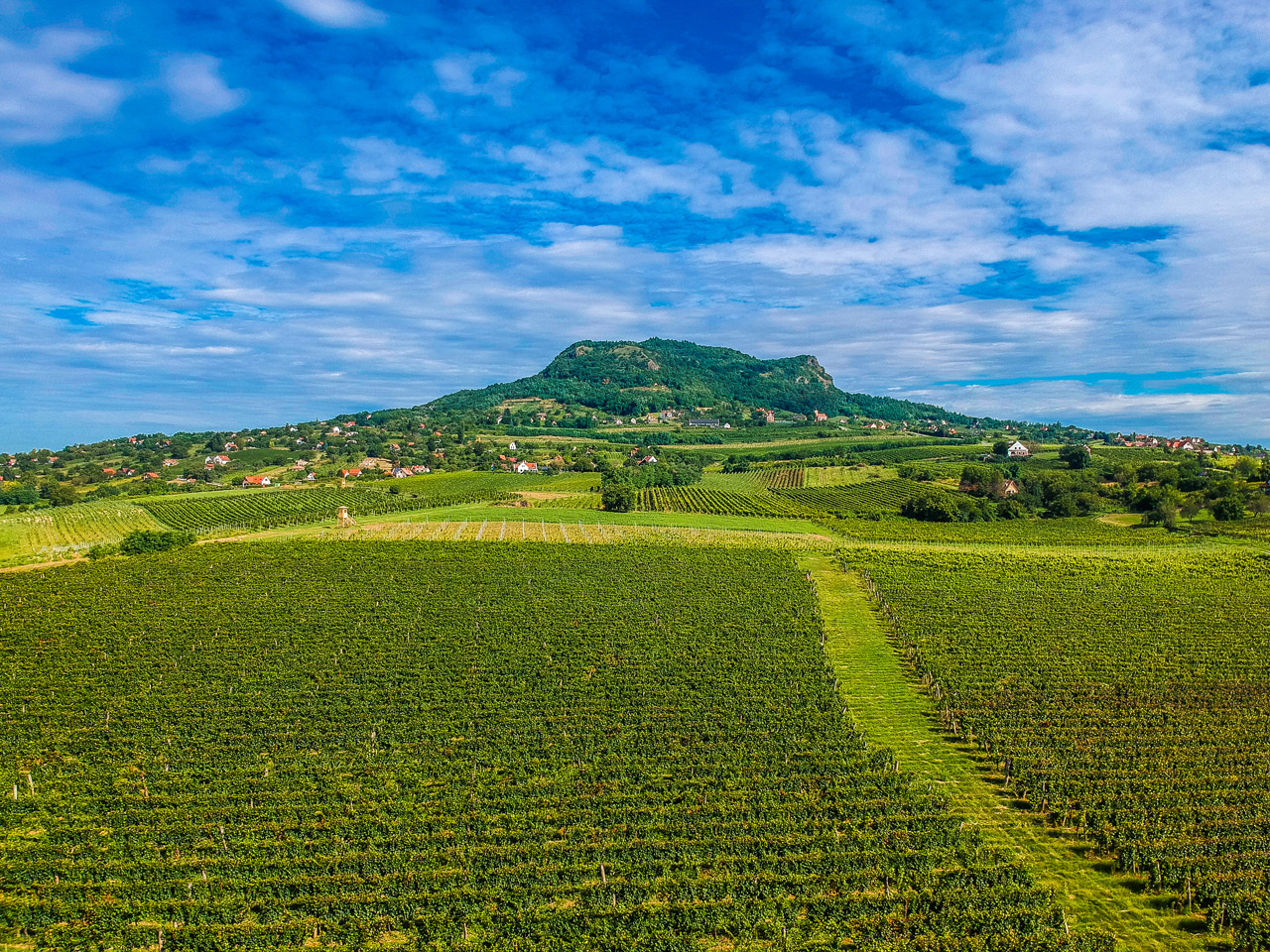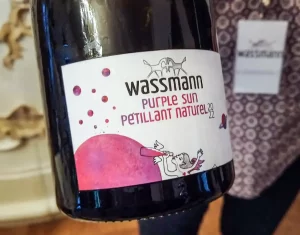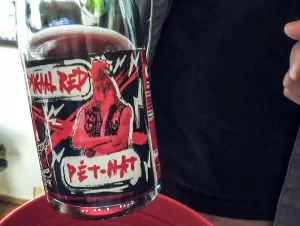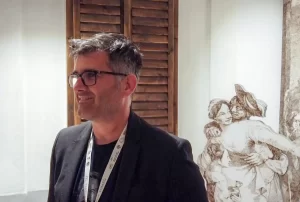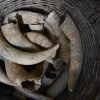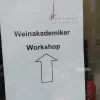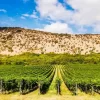Natural wine is a growing trend in the wine world, with more and more wine lovers seeking out bottles that are made with minimal intervention.
But what exactly is natural wine, and why has it become so popular? Put simply, natural wine is a wine that is made with minimal or no additives, using only grapes that are grown using organic farming methods. In Hungary with the 26/2021 (VII. 29.) legislation there is a legal definition if a producer wants to put the word „natúr” (Hungarian for natural) on the label. The grapes must come from organically certified production, only hand harvest is permitted and a minimal intervention must be followed (see full details in Hungarian here) with a maximum of 40 mg/l total sulphur dioxide. The legislation also defines pet-nat (pétnat) under natural wine (plus the bubbles of course).
The Hungarian natural wine scene is truly exciting, there is a lot to discover and now in its third year the Natúr Sümeg offers a great possibility to meet the people and of course, taste the wines. This is exactly what I did:
Wassmann from Villány
a German husband and wife from Villány with a very deep sense for organic, biodynamic and natural ways of crafting the wines and purity of fruit. Besides the reds (Kékfrankos, Cabernet franc & co.) they also make some really fine orange wines, great fruit vibrant juicy whites with a lovely grip. Reds fruit is driven with freshness. While orange wines must only have a minimum of 7 days of skin contact and by law a minimum potential alcohol of 12%, I find the latter part especially useless regulation as one can achieve perfectly ripe grapes with less potential alcohol as well. The Southern part of Hungary has a wide diversity,
Vaskapu Kastély Winery
is run by Géza Galán with a special focus on Kadarka. Mohács belongs to the Pécs wine district due to the surrounding mountains the soil is high in limestone with some overlying loess and sandstone. Another winery further up north in
Hajós the Sziegl Winery
shares a similar appreciation for Kadarka. It started all with a barrel and some vineyard parcels, some of the very old Kadarka vines sit on the top of the cellars on loess and clayey loess soil. Stunning wines! Travelling even further North you reach the
Bóka Estate
in Pálfa in the Tolna district once again having a strong focus on Kadarka. Got to love the purity, lightness and bright red fruit aromas, and flavours here.
Pálffy Pince and PANK
(Köveskál, Káli Basin /Balaton): father and son, two different wineries and very different „labels” as well as wine styles. The one philosophy they do share is the organic and natural approach, but that’s roughly it. Gyula Pálffy clean and bright wine with a focus on Olasz rizling, Furmint and Riesling (one of the best in the country!). The superb marriage between soil and climate is expressed in the glass. Attila Pálffy (PANK- Pálffy Attila Natural Köveskál) is funky, crazy labels heavy on the pet-nat style, eccentric, unconventional. Following along the Balaton
Kristinus Winery
in the wider area of Balatonboglár belongs to one of the bigger estates but this does not compromise their philosophy which very much follows the notion of soil, sun, moon, and stars. Certified Demeter you’ll find some much-appreciated funkiness in their Kelet Cuvée for instance. A blend of Furmint, Grüner veltliner, Sauvignon blanc with a twist of whole cluster fermented in oak, whole cluster fermented in amphora and destemmed aged in used barrels, respectively.
Nagyváradi Péter Winery
based in Balatonfüred has been around in Hungary and abroad as well as learning the craftmanship to be a winemaker. He has some fascinating Kékfrankos from Tihany, calls it the old name Tichon. Yet as so often the wines are bottled under a much wider geographic indication, Balatonmelléki PGI. I love these tastings since you meet many producers and get to taste their wines which you never had before, like
Aron Molnár
originally from England cultivating just under 3 hectares mainly on the Szent György mountain which sits behind the Badacsony and next to the Csobánc. Aron works with plenty of skin contact yet keeps the fruity personality of the grapes, and wines up front adding a touch of spice. Mount Somló is fascinating for several reasons. Part of the Marcali basin and bordering the so-called „small plain” and Bakony mountain range, it stands out as a single majestic volcanic mountain. Unique, mineral-driven, full-bodied rich white wines with a very distinctive personality. For the premium wines, the local wine government was considering once making organic grape cultivation mandatory. Nevertheless, Somló boosts several natural winemakers who craft fantastic wines.
Weingartner Olivér
works with spontaneous ferments, skin and fine lees and barrels. Delivering a refined notion of varieties.
Tomcsányi Family Winery
represents the mountain with their “fingerprint”, got to love their Hárslevelű expressive with some fine skin contact.
Bálint Barcza
has come a long way, today the focus is on organically grown grapes as well as expressing the Somló at its finest, with the 2018 vintage there has been a change in not just the labels but also an in-depth philosophy. His wines deliver the salty, mineral edge that wine lovers appreciate in the Somló mountain.
Somló Kincse Winery
(literally the treasures of Somló), delivers what the name of the winery suggests: treasures. Some forgotten varieties like Gohér, Budai, Sárfehér, and Bakator. Purity, no intervention, working with nature in hand delivering effortless, and a spicy mineral edge when it comes to describing the wines.
Jumping to the Northwestern area of Hungary the
Turay Family Winery
is shaking up Neszmély with its 2 hectares currently elevating the varieties like Generosa and some PIWI varieties to the next level. Kőszeg stands out as being cool and fresh red wines mainly Kékfrankos, the
Unger Bormanufaktúra
with some very old vines and a single vineyard approach delivers a very much origin-based approach with their wines.
The district of Mátra is a difficult one since it has so much –unused- potential, but this would be a different topic. I instantly suggested
Bálint Losonci Gyöngyöspata
or even Abasár as a separate PDO, Bálint knows Burgundy so there is no need for much explanation. Losonci Winery one of the oldest today in Gyöngyöspate, Bálint’s approach to Syrah the one with a little bit of SO2 is refined, also his whites are exciting.
Levente Winery,
led by Levente Major sources a lot of fruit from the Sár-hegy just around Abasár a very special site with clay, limestone and volcanic andesite, tuff and a remarkable micro-climate delivers stunning wines through the assistance of Levente. His Riesling (2018) is top-notch, but all the others show also great depth and mineral-driven spiciness.
Páger Winery
in Gyöngyöspata small gem of 2 hectares, low-intervention and some funky orange wines plus top wines from the Gereg vineyard.
There is much happening in Mátra!
Last but not least I have not included Sümeg in the wider Balaton, since it’s an own standing PDO and they’re the host of the Natúr Sümeg event.
the creative mindset behind the Natur Sümeg Exhibition makes chalky, mineral-driven whites and several bubbly ones which are worth paying attention to. The
Abeles Winery
run by Imre Halász (he has grapes in Somló as well), puts a high emphasis on freshness and bright, chunky fruity styles with a vibrant finish.
Balázs Capári
originally a vet, and medical professional who is also a brown belt in BJJ, and Dip WSET holder fell in love with wines rather by accident. His wines Chardonnay, Kékfrankos are always pure and rich with a pristine balance (it’s the key word here!) and depth very much resembling what Sümeg stands for.
And there is much more, several other winemakers who make stunning, exciting wines but could not taste them due to the lack of time, but more to come on Natural Wines of Hungary, the people, the land, the story…
May the force of nature be with you!

